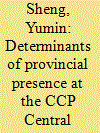|
|
|
Sort Order |
|
|
|
Items / Page
|
|
|
|
|
|
|
| Srl | Item |
| 1 |
ID:
076965


|
|
|
|
|
| Publication |
2007.
|
| Summary/Abstract |
This paper studies China's response to the Severe Acute Respiratory Syndrome (SARS) epidemic in 2003. It first assesses the current nature, structure and development of the Chinese infectious disease system, and then evaluates the state response to infectious disease epidemics. Turning to the role of non-state actors, it discusses their contributions to the state's efforts. Following a case study of Shaanxi province, it concludes that the SARS outbreak reveals the state's capacity to re-centralize power in the face of high-priority events. However, it also concludes that this government capacity alone, while necessary, is not sufficient to overcome SARS.
|
|
|
|
|
|
|
|
|
|
|
|
|
|
|
|
| 2 |
ID:
076967


|
|
|
|
|
| Publication |
2007.
|
| Summary/Abstract |
The World Bank has played an important role in China's economic transformation since the late 1970s. China used the World Bank well and the Bank was responsive to China's needs. The Bank did not recommend early or comprehensive market liberalization or privatization, as it did in some other transition economies, but supported China's pragmatic - learning-by-doing - approach to economic reform. It pushed at the margin for critical institutional and policy reforms, presenting perspective based on international experience, while providing technical assistance in numerous areas, often through Bank-supported projects. As the Chinese gained expertise, confidence and access to international capital markets, the role of the Bank in China inevitably shrank. China now uses the Bank mainly for selective technical, institutional and conceptual innovations for development. China and the World Bank both gained from their interaction.
|
|
|
|
|
|
|
|
|
|
|
|
|
|
|
|
| 3 |
ID:
076966


|
|
|
|
|
| Publication |
2007.
|
| Summary/Abstract |
Drawing on provincial-level time-series cross-section data for the period of 1978-2002, I test hypotheses on the determinants of Chinese Communist Party Central Committee (CC) membership shares for incumbent officials from different provinces. I find that officials from more populous provinces tended to take up higher alternate CC membership shares, but lower full CC membership shares. While urbanization is negatively associated with provincial alternate CC membership shares, there is little support for the role of other economic variables. The constrained nature of alternate CC membership implies greater 'symbolic representation' for the more populous and rural provinces on the national level in this period. These findings, based on considerations of distinct categories of CC membership, do not corroborate arguments sweepingly attributing CC representation to either provincial economic resources or performance.
|
|
|
|
|
|
|
|
|
|
|
|
|
|
|
|
| 4 |
ID:
076959


|
|
|
|
|
| Publication |
2007.
|
| Summary/Abstract |
This paper analyses the capacity of China's central state to control society and implement its policies at the local level, using as a case study the implementation from 1998 of a major policy initiative - 'closing the pits and reducing coal production'. The aims of this policy were to close down many of the TVE (township and village enterprise) mines, thereby ameliorating China's coal safety record, and to reduce output in order to balance supply and demand, thereby improving the situation of the SOE (state-owned enterprise) coal mines. The paper concludes that, despite some success, the state found it difficult to overcome resistance from a powerful coalition of local cadres, mine bosses, workers and farmers who depended directly or indirectly on the mines for their living. It therefore highlights continuing shortfalls in China's state capacity, particularly in situations where the state is trying to control or influence the distribution of economic rents as between different groups in society.
|
|
|
|
|
|
|
|
|
|
|
|
|
|
|
|
|
|
|
|
|